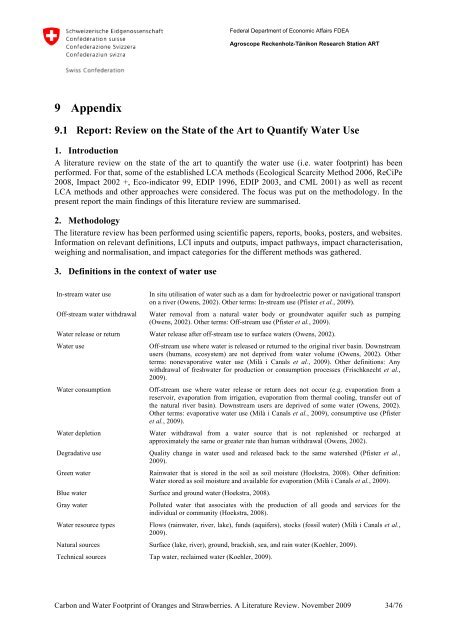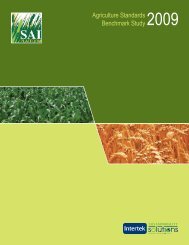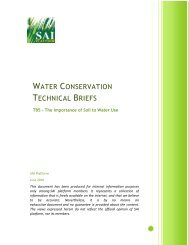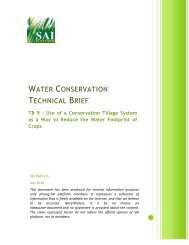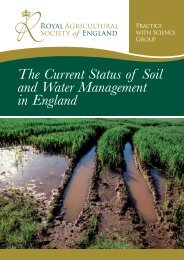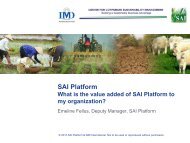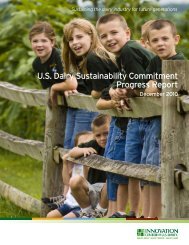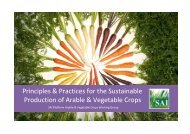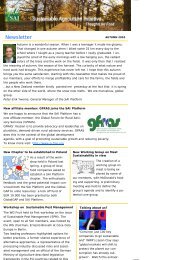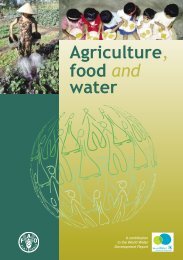Carbon & Water Footprint of Oranges and Strawberries - SAI Platform
Carbon & Water Footprint of Oranges and Strawberries - SAI Platform
Carbon & Water Footprint of Oranges and Strawberries - SAI Platform
You also want an ePaper? Increase the reach of your titles
YUMPU automatically turns print PDFs into web optimized ePapers that Google loves.
Federal Department <strong>of</strong> Economic Affairs FDEA<br />
Agroscope Reckenholz-Tänikon Research Station ART<br />
9 Appendix<br />
9.1 Report: Review on the State <strong>of</strong> the Art to Quantify <strong>Water</strong> Use<br />
1. Introduction<br />
A literature review on the state <strong>of</strong> the art to quantify the water use (i.e. water footprint) has been<br />
performed. For that, some <strong>of</strong> the established LCA methods (Ecological Scarcity Method 2006, ReCiPe<br />
2008, Impact 2002 +, Eco-indicator 99, EDIP 1996, EDIP 2003, <strong>and</strong> CML 2001) as well as recent<br />
LCA methods <strong>and</strong> other approaches were considered. The focus was put on the methodology. In the<br />
present report the main findings <strong>of</strong> this literature review are summarised.<br />
2. Methodology<br />
The literature review has been performed using scientific papers, reports, books, posters, <strong>and</strong> websites.<br />
Information on relevant definitions, LCI inputs <strong>and</strong> outputs, impact pathways, impact characterisation,<br />
weighing <strong>and</strong> normalisation, <strong>and</strong> impact categories for the different methods was gathered.<br />
3. Definitions in the context <strong>of</strong> water use<br />
In-stream water use<br />
Off-stream water withdrawal<br />
In situ utilisation <strong>of</strong> water such as a dam for hydroelectric power or navigational transport<br />
on a river (Owens, 2002). Other terms: In-stream use (Pfister et al., 2009).<br />
<strong>Water</strong> removal from a natural water body or groundwater aquifer such as pumping<br />
(Owens, 2002). Other terms: Off-stream use (Pfister et al., 2009).<br />
<strong>Water</strong> release or return <strong>Water</strong> release after <strong>of</strong>f-stream use to surface waters (Owens, 2002).<br />
<strong>Water</strong> use<br />
<strong>Water</strong> consumption<br />
<strong>Water</strong> depletion<br />
Degradative use<br />
Green water<br />
Off-stream use where water is released or returned to the original river basin. Downstream<br />
users (humans, ecosystem) are not deprived from water volume (Owens, 2002). Other<br />
terms: nonevaporative water use (Milà i Canals et al., 2009). Other definitions: Any<br />
withdrawal <strong>of</strong> freshwater for production or consumption processes (Frischknecht et al.,<br />
2009).<br />
Off-stream use where water release or return does not occur (e.g. evaporation from a<br />
reservoir, evaporation from irrigation, evaporation from thermal cooling, transfer out <strong>of</strong><br />
the natural river basin). Downstream users are deprived <strong>of</strong> some water (Owens, 2002).<br />
Other terms: evaporative water use (Milà i Canals et al., 2009), consumptive use (Pfister<br />
et al., 2009).<br />
<strong>Water</strong> withdrawal from a water source that is not replenished or recharged at<br />
approximately the same or greater rate than human withdrawal (Owens, 2002).<br />
Quality change in water used <strong>and</strong> released back to the same watershed (Pfister et al.,<br />
2009).<br />
Rainwater that is stored in the soil as soil moisture (Hoekstra, 2008). Other definition:<br />
<strong>Water</strong> stored as soil moisture <strong>and</strong> available for evaporation (Milà i Canals et al., 2009).<br />
Blue water Surface <strong>and</strong> ground water (Hoekstra, 2008).<br />
Gray water<br />
<strong>Water</strong> resource types<br />
Polluted water that associates with the production <strong>of</strong> all goods <strong>and</strong> services for the<br />
individual or community (Hoekstra, 2008).<br />
Flows (rainwater, river, lake), funds (aquifers), stocks (fossil water) (Milà i Canals et al.,<br />
2009).<br />
Natural sources Surface (lake, river), ground, brackish, sea, <strong>and</strong> rain water (Koehler, 2009).<br />
Technical sources Tap water, reclaimed water (Koehler, 2009).<br />
<strong>Carbon</strong> <strong>and</strong> <strong>Water</strong> <strong>Footprint</strong> <strong>of</strong> <strong>Oranges</strong> <strong>and</strong> <strong>Strawberries</strong>. A Literature Review. November 2009 34/76


